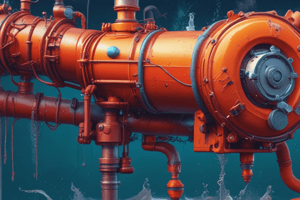Podcast
Questions and Answers
What is one major problem when dissimilar pumps are arranged in series?
What is one major problem when dissimilar pumps are arranged in series?
- The smaller pump may be forced to operate beyond its free delivery flow rate. (correct)
- The volume flow rate through each pump varies significantly.
- Each pump operates at the same pressure rise.
- The power supplied to the smaller pump is maximized.
Why might the smaller pump in a series arrangement act like a head loss?
Why might the smaller pump in a series arrangement act like a head loss?
- It has a higher pressure rise capability than the larger pump.
- It operates at lower efficiency levels than the larger pump.
- It is unable to handle the large head imposed on it. (correct)
- Its performance curve differs greatly from the larger pump.
What happens if two very dissimilar pumps are connected in series?
What happens if two very dissimilar pumps are connected in series?
- Problems may arise due to mismatched performance curves. (correct)
- The net volume flow rate increases significantly.
- The power consumption decreases compared to parallel connection.
- They operate at maximum efficiency.
When centrifugal pumps are connected in series, what is the relationship between the discharge of one pump and the suction side of the second pump?
When centrifugal pumps are connected in series, what is the relationship between the discharge of one pump and the suction side of the second pump?
What could happen if dissimilar pumps in a parallel arrangement are not sized properly?
What could happen if dissimilar pumps in a parallel arrangement are not sized properly?
In what scenario would connecting similar pumps in series or parallel be more suitable?
In what scenario would connecting similar pumps in series or parallel be more suitable?
What is the result of connecting two pumps in series?
What is the result of connecting two pumps in series?
What must be ensured about the casing of the second pump in a series connection?
What must be ensured about the casing of the second pump in a series connection?
Why should you start the second pump after the first pump is running in a series connection?
Why should you start the second pump after the first pump is running in a series connection?
What happens to the head when two identical pumps are arranged in series?
What happens to the head when two identical pumps are arranged in series?
Where does the combined head and flow rate move when two pumps are connected in series?
Where does the combined head and flow rate move when two pumps are connected in series?
What is required to overcome larger system head loss than one pump can handle alone?
What is required to overcome larger system head loss than one pump can handle alone?
What is the relationship between the head for each pump when two pumps with equal performance curves are running in series?
What is the relationship between the head for each pump when two pumps with equal performance curves are running in series?
Why are multistage centrifugal pumps more often used than single stage pumps when operating in series?
Why are multistage centrifugal pumps more often used than single stage pumps when operating in series?
How is the water head added by a centrifugal pump typically measured?
How is the water head added by a centrifugal pump typically measured?
What is the formula for calculating the water head added by a centrifugal pump?
What is the formula for calculating the water head added by a centrifugal pump?
What does the combined/equivalent head formula represent for n pumps connected in series?
What does the combined/equivalent head formula represent for n pumps connected in series?
How does the combined/equivalent flowrate (QE) for n pumps connected in Series compare to that of an individual pump?
How does the combined/equivalent flowrate (QE) for n pumps connected in Series compare to that of an individual pump?
Flashcards are hidden until you start studying



